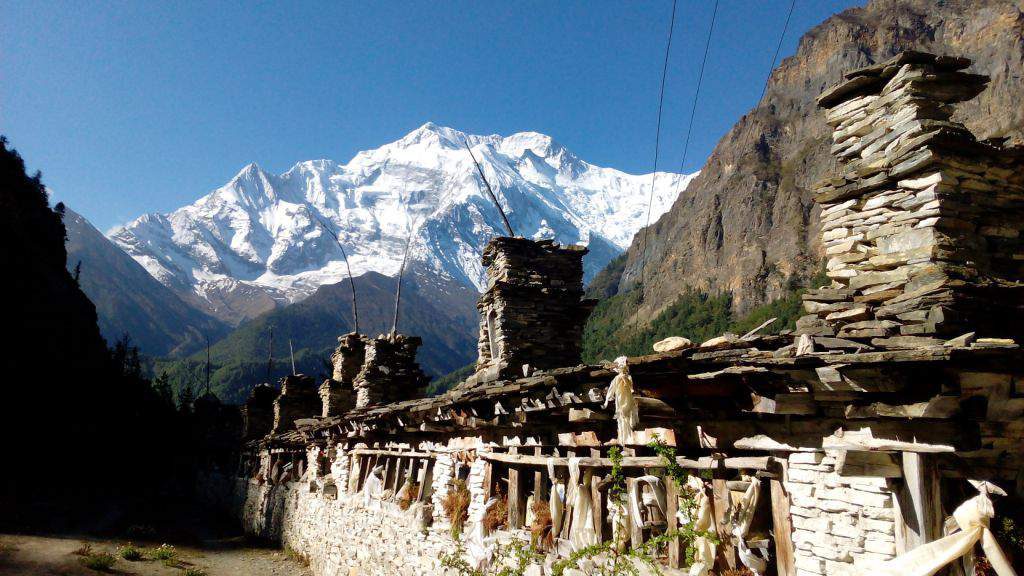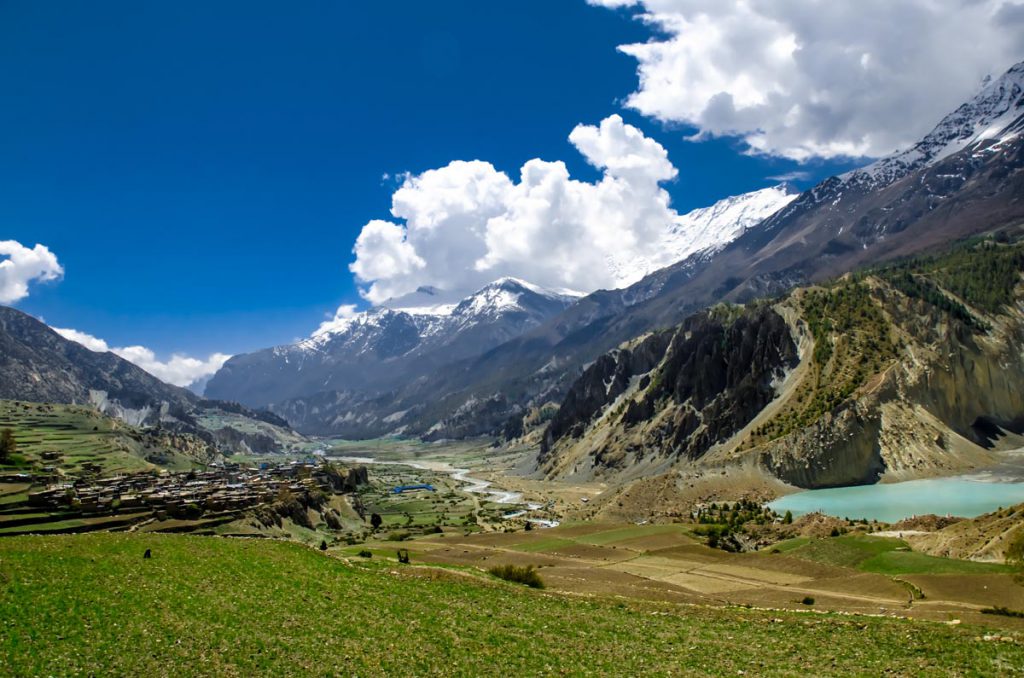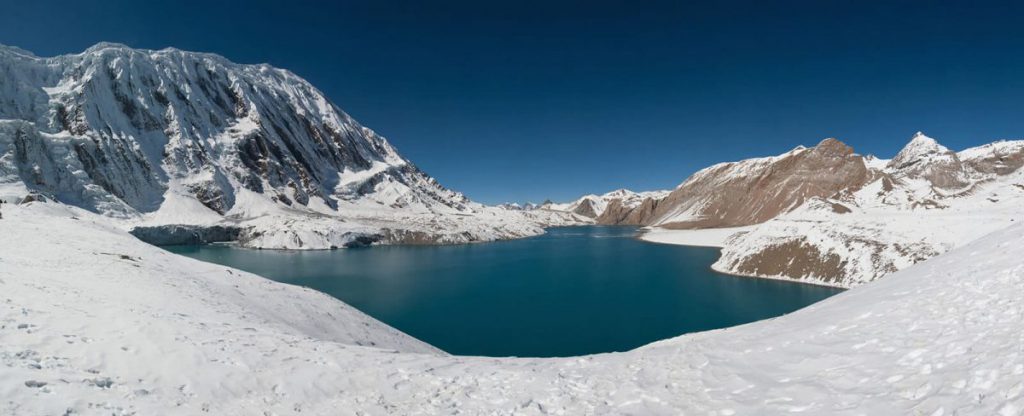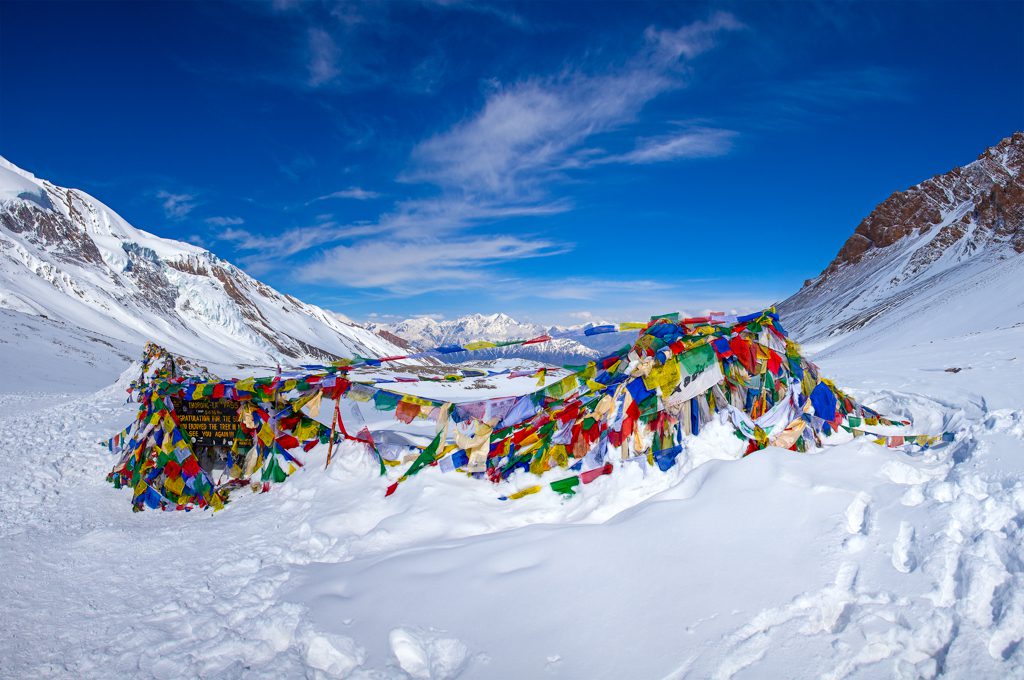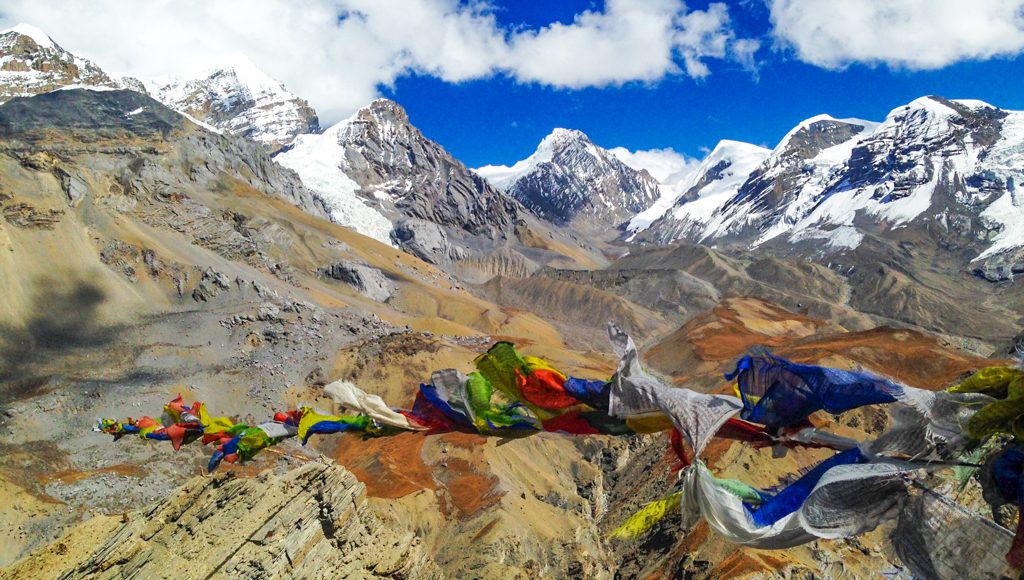Serene and crystal blue, Tilicho Lake is one of the highest lakes in the world. Its very remoteness situated at 4,919M has attracted hardened trekkers from all over the world for decades. The lake holds many mythical stories and it is mentioned in Ramayan an ancient Hindu book. This is a high altitude trek, so care is taken to limit any effects of high altitude with an aclimatisation day built into the itinerary.
Our trek begins from Jagat and follows the Marshyangdi River, with some great views of Manaslu and Himal Chuli to the east. We journey through villages inhabited by a wide diversity of people from different ethnic groups traversing a trail that offers spectacular views of the snow-clad Himalayas. We have customized this route as it is basically the same as Annapurna Circuit to Manang. However instead of trekking the valley north to Tanki Manang and Yak Kharka, the route traverses the main valley to the west to pass through Khanshar Village (The Last Village of Nepal) From here there is a steep trail up to Tilicho lake to capture magical moments, surely to be etched in your memory for years to come, alone in a desolate wilderness with the world all around you. After taking in the beauty of it all we hike on to Yak Kharka then up to the high pass of Thorung La at an elevation of 5416 meters another classic point to stop and wonder on this trek as the high peaks open up before you. From the pass of Thorung La the trek leads down to Holy pilgrimage village of Muktinath then on to Jomsom from where a thirty-five-minute scenic flight through the mountains takes us to the lake town of Pokhara.
Himalaya Heart provides total support to you all the way. Our mountain guides have spent many years leading groups at high altitude and are well able to deal with any problems. Our teams are always well prepared, we provide our porters and support staff with excellent equipment for travel into the mountains. Your trip leader will be paying careful attention to all clients and staff, making sure everyone stays as comfortable as possible and has the best chance of attaining their goals and completing the trip successfully.
- High altitude at its best
- Insight into Buddhist Culture and customs
- Spectacular Mountain views.
- The Holy Pilgrimage site of Muktinath.
- Tour of the Heritage sites in the Kathmandu Valley.
- Beautiful Pokhara.
One of our team will be at the airport to pick you up for the hotel transfer. Here we will go over the tour in more detail and you will meet your guide.A chance for you to ask any questions you may have. The rest of the day is free to explore the bustling streets of Kathmandu
After breakfast we have a full day visiting many of the holy heritage sites around the Kathmandu Valley.It includes visits to the Hanuman Dhoka (Kathmandu Durbar Square) – Swaynunath Buddhist Shrine, Pashupatinath Temple and Boudhanath Stupa.
We leave a busy Kathmandu early soon after breakfast for the drive to the trek start point. It is a great drive and introduction to the rolling hills and rushing rivers of Nepal. Some good views of the mountains on the way,we lunch in Besi Sahar From here we take a local jeep to Syange (1080m) More rivers, local villages and beautiful mountain scenery. The trail runs up and down through paddy fields, passing through tiny villages and ascends through the rhododendron forest to Jagat (1330m). .
The trek begins as we zigzag our way across bridges over the Marsyangdi River. The trail leads fairly steeply uphill before leveling to reach the settlement of Tal. Tal commands some great views of cascading waterfalls and valley views. We are now entering the Manang district. We trek on through barley, rice and potato fields pristine pine forests to the village of Khotro (1860m).From Khotro we drop down to the valley floor to a long suspension bridge there is a true alpine feel. Passing Karte and Nache village to a stone Kani, the formal entrance to Dharapani. A junction for treks either to Manaslu the Manang valley.
After registering at the ACAP office in the village, we start a lovely day with a climb over a spur then through a beautiful forest of blue pine, spruce, hemlock, maple, and oak. We stay on the south bank of the river before a climb through forests to Danaque (2210m).The area is known for its apple orchards. The rest of the day is a series of up and downs along a mule track through forests of oak and maple trees and along a river to reach Chame a great place to overnight. There is a long wall with many prayer wheels Chame is the administrative headquarters of the Manang District. There are fine views of Lamjung, Annapurna II/IV (7525m).
Another fine day ahead today we start with a climb past Mani walls to a field of buckwheat and on to the tiny village Telekhu (2840m). The trail is mostly level walk in forests with some dramatic scenery on the way through a deep gorge. The pine-scented trail rounds a bend to reveal the first views of dramatic Paungda Danda rock face, a tremendous curved slab of rock. We need to trek over a ridge marked by prayer flags and stone cairn and then continue on a steep descent to the upper Marsyangdi. The trail follows through the river valley with great mountain views along the way of Pisang peak and Annapurna II at Pisang. Pisang marks the beginning of the upper the Manang district.
It is a longish day today trail but a very rewarding one with some stunning mountain views. From upper Pisang, the high trail enters pine groves to reveal a turquoise lake. We really feel we are in Buddhist country with the prayer wall ,painted Mandalas and many prayer wheels on the way. We hike through fields of grazing yak and a wide variety of crops. The trail climbs a steep ridge on the right side of the Marsyangdi River to reach Ngawal (3660m). Wow! From here we have one of the really great viewing points of the whole Annapurna Ridge with the Marsyangdi river valley view. On the way, we pass more pine forests, through villages and farming terraces. The large Tibetan settlement of Manang provides Fantastic views of Annapurna II/III/IV, Gangapurna and Tarkekang. Stay at 3570m.
We need to take today adjusting to the altitude for the push to come. Visit to take advice from Himalayan Rescue Association and observe the spectacular views of the Himalayas nearby. The view of the milky blue glacier lake at the foot of spectacular Gangapurna icefall is stunning. We take some hikes to higher altitudes today.
Today we start with a descent from old Manang passing by a Chorten to reach t he Marsyangdi River to then cross a suspension bridge .The trail stays close to the river bed and soon we approach Khangsar. From here superb views of the Great Barrier open up before us. There you find a small monastery, Chorten, Mani walls and prayer flags. Stay overnight at camp in Khangsar.
From Khangsar the trail climbs steeply past a Gompa and small chortens and up through juniper and buckthorn bushes. On the way we cross a few streams and up to reach a crest (4650m) with prayer flags it is tough going. From the crest we have a zig zag descent down a scree slope to Tilicho Base Camp Hotel. A fantastic high mountain feel with panoramic views of Tilicho Mountain and many others
The trail to the Tilicho starts up a side valley then traverses onto moraine, hard work making the long climb to 4710m. There is an outstanding view of Tarkeghyang, Gangapurna and the Khangsar Kang from here. Tilicho Lake, the highest lake in the world at (4920m), presents a particularly dramatic spectacle. Sometimes its turquoise water reflects the surrounding peaks but more often its frozen solid. After spending time soaking up the surreal surroundings, we trek back down to Tilicho base camp via the same way for our overnight stay.
We continue to climb out of the Marsyangdi Valley. The trail follows this valley north as it steadily gains elevation. You have left the large pine trees way below, the vegetation now consists of scrub juniper and alpine grasses. We keep to the high track 400meters or so above Khangsar village passing through the ruins of old Khangsar then follow an unmarked trail which leads around and down to cross the river on an old log bridge between Gunsang and Yak Kharka. It’s fun to see large yaks grazing at Yak Kharka. The view of Annapurna III is excellent.
From Yak Kharka, we follow along the east bank of the Jarsang Khola, then descend to cross a stream over a wooden bridge at 4310m. Blue sheep, and even the elusive Snow- leopard, sometimes magically appear. The crow-like bird choughs, large lammergeiers, and Himalayan griffons circle high overhead. It is sometimes possible to see herds of blue mountain sheep at Phedi. Overnight at Phedi 4400m.
The trail becomes steep immediately after leaving Thorung Phedi, switchbacking up moraines and following rocky ridges as it ascends to the Thorung La pass (5416m). This is also a magic day among many as the snow capped monsters reach out to touch you. The long Great Barrier ridge, as well as Annapurna, Gangapurna and the heavily glaciated peak of Khatung Kang (6484m) in all their . From the pass the trail descends crossing meadows steeply down to Muktinath. One of the most important pilgrimage sites for both Hindus and Buddhists. It is also home to many ethnics Tibetans and holy Buddhists.
Our final day on trek we head for Jomsom but not before taking in the atmosphere of Muktinath with a visit to the temple. Its an easy day today downhill to Jomsom. The trail leads through meadows, crosses streams, that run through fruit trees to finally arrive at Kagbeni,the gateway to Upper Mustang;A fascinating place with its many Chortens and ochre-colored Gompas and ancient monastery. After lunch in Kagbeni we continue trekking to Jomsom on a windy trail along the Kali Gandaki Valley, overnight at Jomsom.
An early morning short mountain flight to Pokhara. The views of Annapurna and Dhaulagiri mountains and the world’s deepest gorge, Kali Gandaki are stunning. On arrival in Pokhara we transfer to our hotel and Relax.The Mountains have not left us however as Pokhara has perhaps the best mountain backdrop on the planet. Relax in one of the lake restaurants perhaps some swimming or boating.
Today we take a morning flight back to Kathmandu arriving at our hotel around midday. The rest of the day is free.We often organise a farewell meal in a local restaurant in the evening
Cost Included
- Private Arrival & Departure transfers
- Kathmandu Hotel accommodation in a double room with breakfast.
- Guided tour of the city with all entry fees to cultural, historical and heritage sites visited.
- Welcome dinner in Kathmandu
- Full board meals (breakfast, lunch and dinner) on trek
- Accommodation in guesthouse / lodge during trek
- Private transportation as described
- Flight from Jomsom-Pokhara.
- Professional guide with extensive experience,
- Comprehensive First Aid Kit
- Necessary Porters to carry all personal gear and group equipment.
- Adequate insurance for all staff including porters.
- All permits and government t
Cost Not Included
- Meals other than mentioned as per mentioned the itinerary,
- Travel insurance, while on trekking,travel insurance should be valid and include helicopter rescue.,
- Nepal entry visa fee you obtain it in Kathmandu airport upon arrival,
- Personal trekking equipment and items of a personal nature expenses such as alcoholic drinks, cold drinks, laundry or mineral water.
- Medical evacuation in case of emergency
- Expenses incurred due to accidents, landslide, strikes, political unrest, etc.
- Travel insurance
Tilicho Lake Trek FAQ
You can bring your sleeping bag from home or you can rent one in Kathmandu or Himalaya Heart will loan you one. Most tea houses also have blankets but we suggest you bring a warm bag with a liner to use with the blankets.
Yes. All of the necessary permits and conservation fees for your trek are included in the price and will be arranged for you by Himalaya Heart prior to your trek. (we prefer doing this on line before your arrival) For certain restricted regions (like Manaslu and Upper Mustang) we need to have a full day in Kathmandu prior to your trek as we need your passport for the permit registration
You can leave your additional luggage at your hotel in Kathmandu or at our company office in Thamel. Either way, your luggage will be waiting for you at your hotel when you return back from your trek.
You can buy virtually everything you need for trekking from down jackets to water bottles in Kathmandu. There is a variety of branded stores as well as a large selection of copied products mainly in Thamel that are of fairly good quality. It’s still worth bringing your own gear if it doesn’t take up too much weight, especially your own trekking boots to avoid any potential issues when purchasing new shoes..
You should bring trekking boots that are comfortable and broken in. There can be some snow at higher altitudes especially when crossing high passes, so it’s good to be prepared for a variety of conditions. Your footwear should be strong and durable. It should have a chunky sole—preferably made of Vibram or another durable material—and should also protect your ankles..
Tipping is not required but is expected, and really depends on how happy you were with the service. Guides (both for trekking and cultural tours), porters, and drivers are typically provided with a tip at the end of their service with you..
You only need to carry your day pack with daily essentials (sunblock, water, hat, light jacket, and camera) Our porters carry the bulk of your gear, such as extra clothing and overnight essentials
All of our guides at Himalaya Heart speak English and have had many years of experience in guiding foreign travelers. It’s a requirement that they all are trained in first aid as well and we carry a first aid kit during the trek.
For group treks (treks that start on a specific date and are open for travelers to join), the group size can range from 2-10 people but typically ends up being around 4-6 people.
If you fall ill during your trek, the course of action depends on what’s wrong. If it’s altitude sickness, moving to lower altitudes and taking altitude medication will solve this in most cases; if it’s severe, our guide will arrange for an emergency evacuation by helicopter Himalayan Heart will cover the initial costs then claim from your insurer (be sure that emergency helicopter rescue is covered in your travel insurance it is an essential requirement before travelling with us). If you have stomach sickness or another type of food or water-related illness, our guide will have medication on-hand for most common illnesses.
When’s the best time to visit Nepal?
The main seasons for trekking are the spring (Mar to May) and autumn (Sep to Nov) when you’ll have clear skies and superb mountain views. The winter (Dec to Feb) is also a great time to visit— these months offer a unique experience and fewer crowds but lower altitude treks are better at this time of year as its cold at night.
What’s it like during the monsoon season?
(Jun to Aug), Most of Nepal experiences heavy rain for a few hours each day. It’s humid, wet, and the trails in the lower regions (Ghorepani, Ghandruk, Langtang, etc) can be quite muddy. If you don’t mind the rain you’ll have the trails to yourself, the skies often clear up in the morning, and certain treks offer stone-paved trails that drain the rain and make for easy trekking. Also, certain regions, like Mustang and the upper reaches of Everest, lie in the rainshadow of the Himalaya and receive little rain but views however are still likely to be restricted.
What’s the difference between private and group tours?
Private tours are tailor-made itineraries built by us around your travel dates and personal interests, whereas group trips are pre-packaged and depart on specific dates. Group trips are also open for others to join, whereas private trips are just for you. You will find a list of fixed departure dates on our website.
How do I get my visa for Nepal?
For most nationalities visa can be obtained on arrival in Kathmandu. It takes around 45 minutes and is the most convenient way to get your visa you will need passport size photos.. You can also apply for a visa in advance from a local Nepali consulate in your country if you’d like to have everything arranged in advance. Cost15 Days – 25 USD / 30 Days – 40 USD / 90 Days – 100 USD
How much luggage can I take on domestic flights?
For mountain flights, you’re allowed 5 kg. carry-on to the plane and 10 kg. for checked-in luggage. For non-mountain sector flights, the check-in allowance increases to 20-25 kg.
Are hotels included in the tour price?
Himalaya Heart organises complete tours, meaning everything is taken care of from the moment you arrive in Nepal to the moment you leave, including all of your accommodation in a three star Hotel. If you require better accommodation please let us know and we can arrange this and adjust the tour cost accordingly. Each of our tour pages shows clearly what is and what is not included in the tour price.
Are there any extra expenses not included in my tour price?
Personal expenses (tips, soft drinks, bar bills, laundry, telephone calls, donations, and extra snacks, etc) are not included in your tour price. When checking a particular trek page on our website we have clearly stated what is and what is not included. If you’re going trekking, the only things you’ll need to pay for out of pocket are wifi and battery charging (when available), extra meals outside of what’s included, alcohol, and soft drinks and perhaps hot showers.

 +977 9851093973 (Thakur)
+977 9851093973 (Thakur)